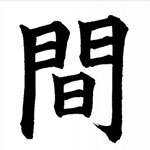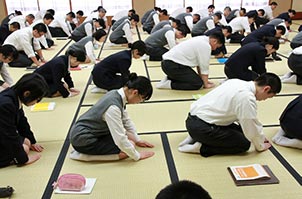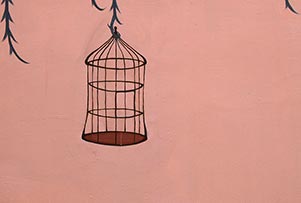When Less is More: Japanese Concept of "MA", Minimalism and Beyond
Posted by Yukiko Kisaki on 16th Sep 2023
Where there is clutter, even valuable things lose their value. Where there is too much, nothing stands out.
The essence of Japanese aesthetic is a concept called 'MA' (pronounced "maah") — the pure, and indeed essential, void between all "things."

A total lack of clutter, MA is like a holder within which things can exist, stand out and have meaning.
MA is the emptiness full of possibilities, like a promise yet to be fulfilled.
(Picture to the right is the Japanese kanji character for MA.)
Minimalism and Beyond
 Look at it this way: When you feel there is too much clutter, it is not because you have too many things; it is rather because you don't have enough MA.
Look at it this way: When you feel there is too much clutter, it is not because you have too many things; it is rather because you don't have enough MA.
The presence of MA makes the minimalism of a Japanese tatami room so serene. However, minimalism is limited to physical form and space, where MA is not.
MA, in essence, is what makes minimalism possible. MA is in the purposeful pauses in a speech which make words stand out. It is in the quiet time we all need to make our busy lives meaningful, and in the silence between the notes which make the music.
MA is what creates the peace of mind (called heijoshin in Japanese) we all need so that there is room for our thoughts to exist properly and to thrive.
Examples in Daily Living
 MA is manifest in Japanese living architecture, garden design, music, flower arrangements (Ikebana) and poetry.
MA is manifest in Japanese living architecture, garden design, music, flower arrangements (Ikebana) and poetry.
However, far from being just a philosophical or artistic concept, MA is ever-present in all aspects of Japanese daily life.
As a small example, when Japanese are taught to bow in early age, they are told to make a deliberate pause at the end of the bow before they come back up — as to make sure there is enough MA in their bow for it to have meaning and look respectful.
Similarly, a tea break in a busy day has to be in a quiet place, away from the routines of work — so that one can soak in the serenity of MA before getting back to busy life.
Negative Space (and time?)
 Artists understand the importance of "negative space" which surrounds an object in an image. Its use can have a dramatic impact on the mood and tone of the finished work.
Artists understand the importance of "negative space" which surrounds an object in an image. Its use can have a dramatic impact on the mood and tone of the finished work.
MA takes the concept of negative space farther, to define a continuum which spans both space and time.
In our busy lives, it is easy to feel there is not enough time to do everything properly. However, no matter how little time we can devote to any task, it has to have a deliberate beginning and a purposeful end, albeit short. Otherwise, our time goes by filled with one thing after another, like an essay with a lot of words — without complete sentences, paragraphs, commas, and periods.
A Poetic View
 Here is an old poem about the meaning of MA:
Here is an old poem about the meaning of MA:
Thirty spokes meet in the hub,
though the space between them is the essence of the wheel.
Pots are formed from clay,
though the space inside them is the essence of the pot.
Walls with windows and doors form the house,
though the space within them is the essence of the house.
Finding Fulfillment: The Art of Letting Go
In the relentless pursuit of modern life, many of us are driven by a desire to possess and control. We seek to accumulate material wealth, status, and experiences, believing they will bring us happiness and fulfillment. However, this constant chase often leaves us feeling empty, overwhelmed, and disconnected.
To live life fully is to navigate it with grace, appreciate its infinite possibilities, and create our "space within" for everything we love and want to have — not by relentlessly wishing to possess, but by letting go.
This is the essence of MA.
Note: This post was first published on August 15, 2011. It was updated on September 16, 2023.

